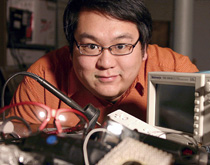
On a return flight from a conference in California, Johnny Lee, a PhD candidate in Human Computer Interaction, and Jason Hong, an HCI professor, end up talking about the Nintendo Wii. They both believe that the popular video game system—with its wireless remote that can sense movement—has potential beyond games. The professor offers the student an enticement: If you come up with interesting projects with the Wii, I'll buy some for the lab.
Lee spends the next few months working on his thesis, but then it's game time. In a few weekends, he comes up with some unique and inexpensive applications for Wiimote, and, in a series of YouTube videos, offers demonstrations, including:
- Tracking multiple fingers in mid air, creating an interface straight from science fiction;
- A light pen that interacts with a monitor or projection image, allowing the user to control a computer or turn a projected surface a into 21st-century Etch 'a Sketch;
- Head tracking, which turns a 2-D screen into a 3-D experience, even making it possible to look behind objects on a monitor through head movements.
Wiimote uses have popped up everywhere--from grade-school science projects, to digital whiteboards in classrooms, to headsets serving as flight simulators. Lee (CS'08) marvels at how YouTube, through more than 10 million combined views of his videos, spread the Wiimote word. "Otherwise," he says, "it would probably be just another failed startup." For his virtual gamesmanship, Lee, now a Microsoft researcher, was recently named one of the top 35 innovators younger than 35 by Technology Review, joining past winners such as the founders of Google.
For more information, visit: johnnylee.net



